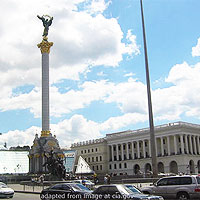The high price of democracy in Ukraine

(opendemocracy.net – Andrii Ianitskyi – January 5, 2015)
Andrii Ianitskyi was born in Sevastopol in 1983 and since 2007 has been living in Kyiv, the Ukrainian capital. He graduated from the Sevastopol branch of Moscow State University in 2007 and became a qualified journalist before working as a journalist and editor in the business media, for companies including Ukrainian News, Kommersant-Ukraine and Delo. He also writes for socio-political online publication LB.ua.
Ukraine is almost bankrupt. The budget for 2015 is unrealistic. Root and branch reform has stalled. There is a war still going in the east of the country. Where now?
On 9 December, the Financial Times published an article entitled ‘IMF warns Ukraine bailout at risk of collapse’, which claimed that Kyiv will need additional aid of $15 billion to avoid default. This was confirmed by European Commission President, Jean-Claude Junker, on 17 December, during a session of the European Parliament. ‘The assessment of Ukraine’s financing gap has been completed by the IMF. Ukraine will need $15 billion in addition to what is already planned.’
But a bailout by itself is not enough. If the country does not radically cut spending and streamline its services, it will go bankrupt. On 19 December, Standard & Poors downgraded Ukrainian foreign debt to CCC with a negative outlook. Ukraine is at risk of a sovereign default in the next six months.
The numbers
Ukraine has endured a year of revolution and military conflict with its eastern neighbour (although Russian president Vladimir Putin maintains that only ‘Russian volunteers’ are fighting in eastern Ukraine, and not regular forces). Russia also annexed Crimea, describing it as ‘sacred territory.’
All this, together with the mismanagement of previous years, has dealt Ukraine a mortal economic blow. Without foreign assistance, there is only one way out of the crisis – default. But Western creditors have not allowed Ukraine to go bankrupt.
On 30 April, the IMF approved a two-year Stand-By Arrangement (SBA) for Ukraine of $17.1 billion, of which some $4.6 billion has already been transferred. Apart from this, the EU, World Bank, USA, Canada, and Japan have all promised large sums. Before November, Ukraine had received at least $4.8 billion from these sources, according to economic analyst Yulia Shibalkina, from CASE Ukraine.
This means Ukraine has already received some $9.4 billion from various sources and will receive the remaining part of the IMF loan (at least $12.5 billion) in 2015. Now, however, the IMF calculates that another $15 billion will be needed.
Foreign aid has, for the time being, allowed Ukraine to pay its existing foreign currency debts and buy Russian gas, but it does not allow it to support previous levels of domestic spending. Nor will root and branch reform be possible without a serious reduction in Ukrainian standards of living.
The deficit for the whole government finance sector (not just the budget) reached 10% of GDP ($12.7 billion) in 2014, says the director of the Bleyzer Foundation, Oleg Ustenko. Foreign aid cannot completely plug this gap.
Ukraine is thus having to put in place its own ‘quantitative easing’ by issuing government-backed securities to support its banking sector as well as subsidising cheap gas tariffs and other utilities, for the general population. This monetary easing is one of the main reasons why the hryvnia has slipped from 8 to 16 to the dollar since the start of the year. And that is just the official exchange rate – on the black market, dollars sell for up to 20 hryvnias.
The ‘breadline’ statistics
Imported goods, including medicine, petrol, white goods, and automobiles, have become more expensive in Ukraine. Foreign trips and purchases have become a luxury.
At the start of the year about 22.1% of Ukrainians lived below the absolute poverty line, which is to say they spent less than 1,218 hryvnias a month ($80 at the official conversion rate). That ‘breadline’ statistic is an artificial one – the government has not re-calculated this amount in 2 years; it has not updated the ‘bare minimum’ shopping basket for 14 years.
With the economy contracting and unemployment rising, at the beginning of 2015 there may be a great many more families facing poverty, says Ella Libanova, director of the Institute of Demographic and Social Research at Ukraine’s National Academy of Sciences.
Apart from the country’s traditional poverty, there is also the so-called ‘new poverty’ of the country’s internally displaced persons (IDPs). The UN reports that on 12 December there were at least 542,000 IDPs coming from Russian-occupied Crimea as well as the Donetsk and Luhansk Regions, where the military conflict continues.
Many IDPs have lost their livelihoods and incomes. Often they are unable to find work in their new locations, rent or buy accommodation, and are discriminated against by both ordinary people and government officials.
Article also appeared at opendemocracy.net/od-russia/georgy-borodyansky/battle-for-siberian-harvest bearing the following notice:
 This article is published under a Creative Commons Attribution-NonCommercial 3.0 licence. If you have any queries about republishing please contact us. Please check individual images for licensing details.
This article is published under a Creative Commons Attribution-NonCommercial 3.0 licence. If you have any queries about republishing please contact us. Please check individual images for licensing details.
